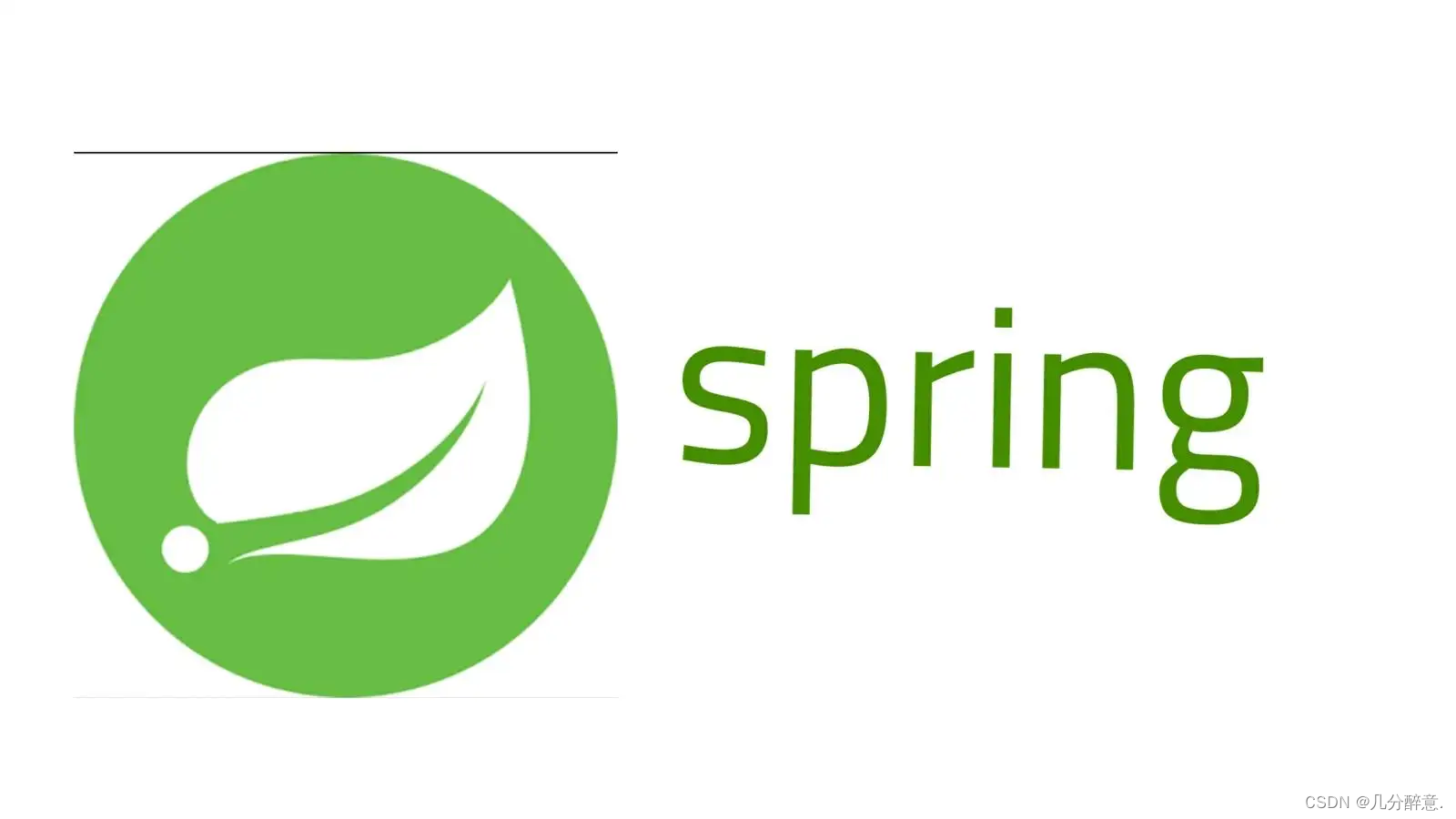
个人主页: 几分醉意的CSDN博客_传送门
本文目录
💖loC 控制反转
loC,Inversion ofControl:
控制反转,是一个理论,一个指导思想。指导开发人员如何使用对象,管理对象的。把对象的创建,属性赋值,对象的声明周期都交给代码之外的容器管理。
loC分为控制和反转
**●
控制:
**对象创建,属性赋值,对象声明周期管理。
**●
反转:
把开发人员管理对象的权限转移给了代码之外的容器实现。由容器完成对象的管理。
●
正转:
开发人员在代码中,使用new构造方法创建对象。开发人员掌握了对象的创建,属性赋值,对象从开始到销毁的全部过程。开发人员有对对象全部控制。**
**
通过容器,可以使用容器中的对象(容器已经创建了对象,对象属性赋值了, 对象也组装好了)。 Spring就是一个容器,可以管理对象,创建对象,给属性赋值。
**
✨loC的技术实现
DI(依赖注入):DependencyInjection,
缩写是DI是loC的一种技术实现。程序只需要提供要使用的对象的名称就可以了,对象如何创建,如何从容器中查找,获取都由容器内部自己实现。
依赖名词:比如说ClassA类使用了ClassB的属性或者方法,叫做ClassA依赖ClassB。
publicclassClassB{publicvoidcreat(){}}publicclassClassA{//属性privateClassB b =newClassB();publicvoidbuy(){
b.creat();}}
执行ClassA的buy()ClassA a =newClassA();
a.buy();
注意:Spring框架使用的DI实现loC.通过spring框架,只需要提供要使用的对象名称就可以了。从容器中获取名称对应的对象。spring底层使用的反射机制,通过反射创建对象,给属性。
✨实现步骤
**
使用spring: spring作为容器管理对象, 开发人员从spring中获取要使用的对象。
**
实现步骤:
● 新建maven项目
● 加入依赖, 修改pom.xml
spring-context : spring依赖
junit: 单元测试
● 开发人员定义类: 接口和实现类
类也可以没有接口。
接口和实现类定义:和没有spring一样。
● 创建spring的配置文件。 作用:声明对象。
把对象交给spring创建和管理。
使用表示对象声明,一个bean表示一个java对象。
● 使用容器中的对象。
创建一个表示spring容器的对象 ApplicationContext
从容器中,根据名称获取对象,使用getBean(“对象名称”)
✨创建接口和实现类
publicinterfaceSomeService{voiddoSOme();}
publicclassSomeServiceImplimplementsSomeService{@OverridepublicvoiddoSOme(){System.out.println("1");}}
✨创建Spring的配置文件和声明bean
在 src/main/resources/目录现创建一个 xml 文件,文件名可以随意,但Spring 建议的名称为 applicationContext.xml。spring 配置中需要加入约束文件才能正常使用,约束文件是 xsd 扩展名。
<?xml version="1.0" encoding="UTF-8"?><beansxmlns="http://www.springframework.org/schema/beans"xmlns:xsi="http://www.w3.org/2001/XMLSchema-instance"xsi:schemaLocation="http://www.springframework.org/schema/beans http://www.springframework.org/schema/beans/spring-beans.xsd"></beans>
spring标准的配置文件:
beans是跟标签,他的后面是约束文件说明。
beans里面是bean 声明。
bean :用于定义一个实例对象。一个实例对应一个 bean 元素。
id:该属性是 Bean 实例的唯一标识,程序通过 id 属性访问 Bean,Bean
与 Bean 间的依赖关系也是通过 id 属性关联的。
class:指定该 Bean 所属的类,注意这里只能是类,不能是接口。
下面我们开始创建Spring配置文件吧
<?xml version="1.0" encoding="UTF-8"?><beansxmlns="http://www.springframework.org/schema/beans"xmlns:xsi="http://www.w3.org/2001/XMLSchema-instance"xsi:schemaLocation="http://www.springframework.org/schema/beans http://www.springframework.org/schema/beans/spring-beans.xsd"><!--声明对象
id:自定义对象名称,唯一值。(可以没有,spring可以提供默认名称)
class:类的全限定名称,spring通过反射机制创建对象,不能是接口
spring根据id,class创建对象, 把对象放入到spring的一个map对象。
map.put(id,对象)
--><beanid="someService"class="youfei1_v.service.impl.SomeServiceImpl"/></beans>
✨创建spring容器对象
publicclassAppMain{publicstaticvoidmain(String args[]){//SomeService service = new SomeServiceImpl();//service.doSome();//1.指定spring配置文件: 从类路径(classpath)之下开始的路径String config="beans.xml";//2.创建容器对象, ApplicationContext 表示spring容器对象。 通过ctx获取某个java对象ApplicationContext ctx =newClassPathXmlApplicationContext(config);//3.从容器中获取指定名称的对象, 使用getBean(“id”)SomeService service =(SomeService) ctx.getBean("someService");//4.调用对象的方法,接口中的方法
service.doSome();}}
测试类
//spring创建对象, 调用是类的那个方法?//默认是调用类的无参数构造方法。@Testpublicvoidtest01(){String config="beans.xml";ApplicationContext ctx =newClassPathXmlApplicationContext(config);// SomeService service = (SomeService) ctx.getBean("someService");// service.doSome();//按照类型获取对象,就不用转换对象了SomeService service = ctx.getBean(SomeService.class);
service.doSome();}
ApplicationContext介绍
✨spring容器创建对象的特点
1.容器对象ApplicationContext:接口
通过ApplicationContext对象,获取要使用的其他iava对象,执行getBean(“bean的id”
2.spring默认是调用类的无参数构造方法,创建对象
3.spring读取配置文件,一次创建好所有的java对象,都放到map中。
publicclassSomeServiceImplimplementsSomeService{/**
* spring默认使用的无参数构造方法,创建对象。
* 如果定义了有参数构造方法, 应该在定义无参数构造方法
*/publicSomeServiceImpl(){System.out.println("SomeServiceImpl的无参数构造方法");}}
//spring创建对象, 调用是类的那个方法?//默认是调用类的无参数构造方法。@Testpublicvoidtest01(){String config="beans.xml";ApplicationContext ctx =newClassPathXmlApplicationContext(config);//SomeService service = ctx.getBean(SomeService.class);//service.doSome();SomeService service =(SomeService) ctx.getBean("someService");
service.doSome();}
创建容器对象时会自动创建配置文件中的对象
/**
spring是在什么时候创建的对象?
创建spring容器对象的时候,会读取配置文件,创建文件中声明的java对象。
优点:
获取对象的速度快, 因为对象已经创建好了
缺点:
占用内存
*/@Testpublicvoidtest02(){String config="beans.xml";ApplicationContext ctx =newClassPathXmlApplicationContext(config);//SomeService service = (SomeService) ctx.getBean("someService");//service.doSome();}
/**
* spring容器创建对象, 一次创建几个 ?
* 在创建容器(ApplicationContext)对象时,会把配置文件中的所有对象都创建出来(spring的默认规则)(有几个bean就创建几个对象)
*/@Testpublicvoidtest03(){String config="beans.xml";ApplicationContext ctx =newClassPathXmlApplicationContext(config);//SomeService service = (SomeService) ctx.getBean("someService");//service.doSome();}
✨创建非自定义类的对象
Spring配置文件
<?xml version="1.0" encoding="UTF-8"?><beans xmlns="http://www.springframework.org/schema/beans"
xmlns:xsi="http://www.w3.org/2001/XMLSchema-instance"
xsi:schemaLocation="http://www.springframework.org/schema/beans http://www.springframework.org/schema/beans/spring-beans.xsd"><!--创建非自定义对象--><bean id="mydate"class="java.util.Date"/></beans>
测试
//让spring创建非自定义类的对象//有class就能让spring创建对象@Testpublicvoidtest05(){String config="beans.xml";ApplicationContext ctx =newClassPathXmlApplicationContext(config);Date date =(Date) ctx.getBean("mydate");System.out.println("date==="+date);}
✨创建没有接口的类的对象
//没有接口的类publicclassOtherService{publicvoiddoOther(){System.out.println("执行OtherService的doOther()");}}
Spring配置文件
<?xml version="1.0" encoding="UTF-8"?><beans xmlns="http://www.springframework.org/schema/beans"
xmlns:xsi="http://www.w3.org/2001/XMLSchema-instance"
xsi:schemaLocation="http://www.springframework.org/schema/beans http://www.springframework.org/schema/beans/spring-beans.xsd"><bean id="otherService"class="com.service.OtherService"/></beans>
测试
//有class就能让spring创建对象@Testpublicvoidtest05(){String config="beans.xml";ApplicationContext ctx =newClassPathXmlApplicationContext(config);OtherService service =(OtherService) ctx.getBean("otherService");
service.doOther();}
✨获取容器中对象的信息
/**
* 获取容器中对象的信息
*/@Testpublicvoidtest04(){String config="beans.xml";ApplicationContext ctx =newClassPathXmlApplicationContext(config);//获取容器中定义对象的数量 。一个bean对应一个对象int nums = ctx.getBeanDefinitionCount();System.out.println("容器中定义对象的数量=="+nums);//获取容器中定义的对象名称String names[]= ctx.getBeanDefinitionNames();for(String name:names){System.out.println("容器中对象的名称=="+name);}}
版权归原作者 几分醉意. 所有, 如有侵权,请联系我们删除。